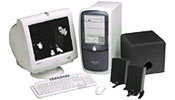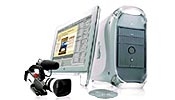Make Your Own DVD! Page 2
Since these machines come with only basic DVD authoring packages - Apple's iDVD and Sonic's DVDit! LE - I didn't expect to give my disc the kind of advanced features, like full-motion menus and secondary audio tracks, that you find on store-bought DVDs. But I hoped at least to create an eye-catching opening screen with links to scenes in my movie and a gallery of stills. So after transferring the 14 minutes of footage to each hard drive, I grabbed a selection of frames for the gal lery using each system's video editing program.
 Compaq's MyMovieStudio option basically consists of an IEEE 1394 connection, StudioDV video editing software, and the DVD authoring software. Once you've transferred your footage from a digital camcorder to the hard drive, you can edit it, add titles and effects, and capture still images (saved in BMP format) with the feature-packed StudioDV program, which I favorably reviewed alongside Apple's original iMovie program in "Video Editing Made Easy" (July/August 2000). StudioDV features an MPEG-2 output option to translate your digital A/V file into the preferred format for DVDs.
Compaq's MyMovieStudio option basically consists of an IEEE 1394 connection, StudioDV video editing software, and the DVD authoring software. Once you've transferred your footage from a digital camcorder to the hard drive, you can edit it, add titles and effects, and capture still images (saved in BMP format) with the feature-packed StudioDV program, which I favorably reviewed alongside Apple's original iMovie program in "Video Editing Made Easy" (July/August 2000). StudioDV features an MPEG-2 output option to translate your digital A/V file into the preferred format for DVDs.
All Apple computers equipped with a Fire Wire connection - which means certain iMacs and all G4 models, whether desktop or laptop - come with the iMovie 2 video editing software that I reviewed in January's "Multimedia Ma ven." Like StudioDV, this simple-to-use program lets you spruce up your footage and capture stills (saving them in Apple's proprietary PICT format). The version bun dled with the desktop G4 that I used adds an Export for DVD option that encodes your video in MPEG-2 format.
 Apple's iDVD Once you've exported your MPEG-2 movie, you launch iDVD. If you're intimidated by the idea of DVD authoring, fear not: iDVD outdoes even iMovie 2 on the ease-of-use front, providing an intuitive, idiot-proof way to get your video footage and still images onto disc.
Apple's iDVD Once you've exported your MPEG-2 movie, you launch iDVD. If you're intimidated by the idea of DVD authoring, fear not: iDVD outdoes even iMovie 2 on the ease-of-use front, providing an intuitive, idiot-proof way to get your video footage and still images onto disc.
- Log in or register to post comments



































































